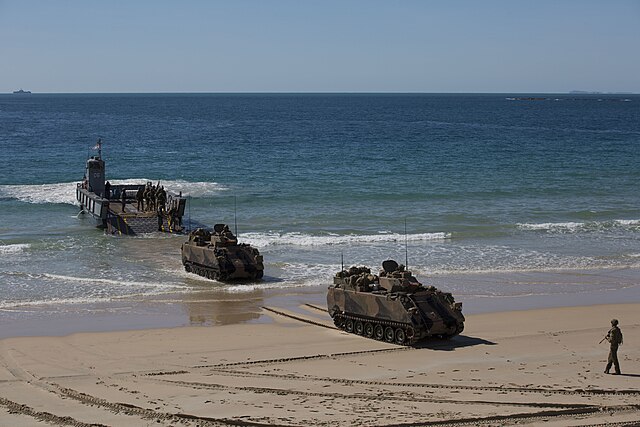The Battle of Inchon, also spelled Battle of Incheon, was an amphibious invasion and a battle of the Korean War that resulted in a decisive victory and strategic reversal in favor of the United Nations Command (UN). The operation involved some 75,000 troops and 261 naval vessels and led to the recapture of the South Korean capital of Seoul two weeks later. The code name for the Inchon operation was Operation Chromite.
General of the Army Douglas MacArthur (center) grasps General J. Lawton Collins (the Army Chief of Staff, left) and Admiral Forrest Sherman (the Chief of Naval Operations, right) upon their arrival in Tokyo, Japan. MacArthur used their meeting to convince other military leaders that the assault on Incheon was necessary.
A Vought F4U-4B Corsair of Fighter Squadron 113 (VF-113) (the "Stingers") flies over UN ships off Incheon, Korea, on 15 September 1950. VF-113 was assigned to Carrier Air Group Eleven (CVG-11) aboard the aircraft carrier USS Philippine Sea. The battleship USS Missouri is visible below the Corsair.
The beach of Pohang in 2008. Here, UN forces landed unopposed in 1950
A United States Air Force 3rd Bombardment Group (Light) A-26 Invader conducts a rocket attack on the rail yard at Iri, South Korea, in early September 1950 as part of deception operations to draw North Korean attention away from the planned Incheon landings.
Amphibious warfare is a type of offensive military operation that today uses naval ships to project ground and air power onto a hostile or potentially hostile shore at a designated landing beach. Through history the operations were conducted using ship's boats as the primary method of delivering troops to shore. Since the Gallipoli Campaign, specialised watercraft were increasingly designed for landing troops, material and vehicles, including by landing craft and for insertion of commandos, by fast patrol boats, zodiacs and from mini-submersibles. The term amphibious first emerged in the United Kingdom and the United States during the 1930s with introduction of vehicles such as Vickers-Carden-Loyd Light Amphibious Tank or the Landing Vehicle Tracked.
A Crusader tank landing on a beach from a Tank Landing Craft in a 1942 test
South Korean Type 88 K1 MBT comes ashore from an American LCAC in March 2007.
Two Australian M113s disembarking from a landing craft during a training exercise in 2019
The Bayeux Tapestry depicts the 1066 Norman invasion of England with a force of some 8,000 infantry and heavy cavalry landed on the English shore.








